
| Palaeos: |  |
The Cryogenian Period |
| Neoproterozoic | Cryogenian |
| Page Back | Back: Tonian | Back: Mesoproterozoic | Up: Neoproterozoic | References |
| Page Next | Next: Ediacaran | Next: Paleozoic | Timescale |
| Neoproterozoic
Tonian Cryogenian Ediacaran |
"Snowball" Scenarios of the Cryogenian
Weather Reports References |
The Cryogenian is, roughly speaking, the period of "Snowball Earth." During the Cryogenian, the world passed through at least two, and perhaps as many as four, "Ice Ages." At least one of these was so severe that it may have been briefly possible (if stupid) to ski from one pole to the other.
The theory of Snowball Earth and its basic underpinnings are covered in a comprehensive page by Chris Clowes devoted to this subject. What follows here is, by contrast, a sort of mental tillite. Our original thought was to update Chris's work. So, like a glacier, we plowed slowly through some of the massive recent literature on the subject, taking the path of least resistance, scooping up bits and pieces of ideas and scientific debris, pushing this ever-growing mound of random factoids before us. However, we realized at last that we weren't going to be able to improve on Chris's original. In fact, after writing over 3000 words on this topic, we discovered that we probably had no idea what this was all about. So, at that point, we simply melted away and dropped this enormous, unconsolidated mass of poorly-sorted data and erratic errata as a sloppy moraine, where you have been so unwise as to stumble across it. And that is also just about as far as we care to push this particular metaphor.
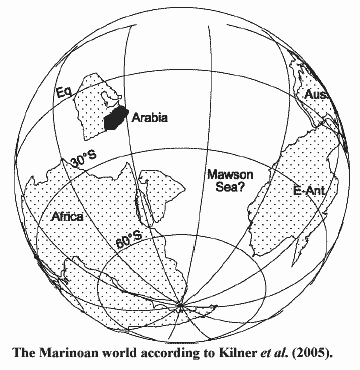 Since we admittedly have no idea how to fit the data together, we have simply
organized our treatment around (a) particular phenomena that require explanation
and (b) the reasons why we can't explain them. The
fundamental background can be very quickly summarized as follows. Between
the break-up of Rodinia (> 750 Ma) and the base of the Cambrian (544 Ma) the
Earth passed through at least two severe episodes of deep freezing. The
first is often called the Sturtian and is commonly dated at between 760 and 700
Ma. The second is called the Marinoan. The dates given for
"the" Marinoan glaciation vary from about 650 to 550 Ma. There
is some consensus (perhaps not based on evidence) that the
Sturtian was a single, world-wide event. There is considerable suspicion
(based mostly on a lack of evidence) that the Marinoan was not.
Since we admittedly have no idea how to fit the data together, we have simply
organized our treatment around (a) particular phenomena that require explanation
and (b) the reasons why we can't explain them. The
fundamental background can be very quickly summarized as follows. Between
the break-up of Rodinia (> 750 Ma) and the base of the Cambrian (544 Ma) the
Earth passed through at least two severe episodes of deep freezing. The
first is often called the Sturtian and is commonly dated at between 760 and 700
Ma. The second is called the Marinoan. The dates given for
"the" Marinoan glaciation vary from about 650 to 550 Ma. There
is some consensus (perhaps not based on evidence) that the
Sturtian was a single, world-wide event. There is considerable suspicion
(based mostly on a lack of evidence) that the Marinoan was not.
The Snowball Earth theory, as articulated by Hoffman et al. (1998), remains the best-articulated, most complete, and best reasoned explanation. That may not be saying a great deal. Hoffman is a really outstanding writer, and one reads his global explanations with a happy sense of revelation and full understanding. Sadly, this sensation is somewhat illusory, as we will see. Still, Snowball Earth is the leading contender. Briefly, Snowball Earth begins with the observation that, if ice sheets extend to 30º latitude or so, the albedo of all that ice reflects so much incoming solar radiation that the rest of the planet quickly freezes, becoming encased in an ice sheet about 1000 m thick. Over a period of time (2-20 Ma), carbon dioxide accumulates in the atmosphere from volcanic sources. When the carbon dioxide reaches a critical threshold, the greenhouse effect of this gas causes an equally extreme hothouse which rapidly melts the glaciers and raises temperatures to about 50º C for a short period before the excess carbonate is absorbed by weathering, and/or directly by the oceans, and precipitates out as carbonates. The strongest evidence for the model is the existence of "cap" carbonates [2] associated with all major glacial deposits of the era. These show extraordinary features, such as meter-long crystals of dolomite, which suggest very rapid formation.
"So, what's the problem?" you say. That's just what we thought -- about 3000 wasted words ago. We have thrown out all those words, and we now begin again:
The Hoffman version of Snowball Earth grew out of extensive fieldwork in Southwest Africa, mostly on the coast of Namibia. One of the striking things about that region was the presence of glacial deposits on the Congo and Kalahari Cratons, which were said to be near the equator during the relevant parts of the Neoproterozoic. In fact, Hoffman et al. have postulated that an unusual clustering of all major continents around the equator contributed strongly to the initiation of icehouse conditions -- an initiation they otherwise don't do much to explain. See Hoffman & Schrag (2000); Halverson et al. (2002); Hoffman & Schrag (2002); and especially Schrag et al. (2002).
As it turns out, that isn't likely to be the case. Until very recently, the only decent paleomagnetic data was from Australia, which was on the equator. However, recent information from Oman places it at 20º S latitude at about 600 Ma. Kilner et al. (2005). Given the fact that Africa was more or less fully assembled and wedged into Gondwana at the time (Beyth et al., 2003; Frimmel & Fölling, 2004), and given that Arabia was also about to dock into that system, we can place Namibia fairly accurately -- at about 75° S latitude. See image above. Thus, during the Marinoan, Namibia was emphatically not in the tropics, nor was most of the rest of Gondwana (Australia excepted).
If Kilner et al. are correct, this is a finding that ought to raise eyebrows about some of the other conclusions from Namibia. The Snowball theory demands that glaciation from 30º to the equator ought to be quick. It says nothing about glaciation at the poles. Thus, it is not clear exactly what the "Marinoan" event in Namibia was, or when it occurred.
The Snowball Earth hypothesis concerns frozen seas. It does not demand
frozen continents. Indeed, the lack of precipitation from the dry,
extremely cold atmosphere requires that continental ice shelves be "thin
and patchy." Hoffman
et al. (1998); Kirschvink
et al. (2000). This necessarily follows from the fact that the
water cycle is shut 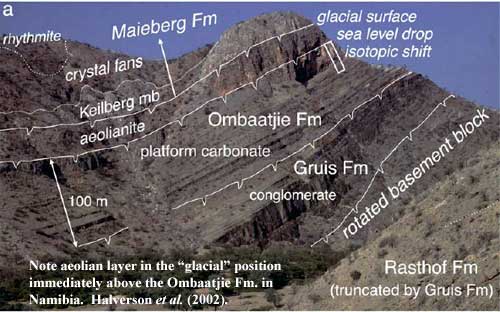 down. Water cannot evaporate through ice cover.
Thus, if continental ice sheets formed at all, they would have been ablated as
the ice age got into high gear. If thick continental ice shelves were
present, this would imply the existence of an active water cycle that should not
exist under hard freeze conditions.
down. Water cannot evaporate through ice cover.
Thus, if continental ice sheets formed at all, they would have been ablated as
the ice age got into high gear. If thick continental ice shelves were
present, this would imply the existence of an active water cycle that should not
exist under hard freeze conditions.
This conclusion seems to apply to Namibia, at least in the Marinoan, but plainly does not apply to Australia or Canada because "Neoproterozoic glacial deposits in Australia and North America are locally thick (>1 km), fill incised paleovalleys (<150 m deep), contain faceted and striated stones, have associated outwash deposits, and record as many as six magnetic polarity reversals. These features indicate that substantial amounts of flowing ice existed on land for time scales of 106 years." Hoffman & Schrag (1999). Accordingly, the authors modified their theory, but failed to state how continental ice could accumulate. They assert that c. 107 years is enough to build a continental ice cover, even at very modest rates of ice accumulation. However, we don't see how there could be any net accumulation, because of the supposed lack of direct connection between sea and atmosphere, and because of the loss of ice cover by gradual sublimation and seaward transport.
On the other hand, in the absence of continental ice masses, we would expect significant amounts of bare ground. This could have an important effect, in that large swathes of wind-borne dust and dirt would drastically reduce the albedo of the sea ice cover, which is needed to maintain the snowball state. Pierrehumbert (2004); Pollard & Kasting (2005).
 Alarums, excursions: Enter Thersites
Alarums, excursions: Enter Thersites
Thersites: Now they are clapper-clawing one another; I'll go look on.
-- Shakespeare, Troilus and Cressida, Act V, Sc. 4
Here we enter the original heartland of the Snowball Earth debate. However, if the string "δ13C" leaves you looking vague and perplexed, we recommend reviewing this remedial footnote: [1].
As the figure shows, the Proterozoic was characterized by a sustained, positive 13C excursion, punctuated by relatively brief episodes of marked instability. The Snowball Earth mechanism purports to explain these instabilities by associating them with Snowball episodes. This association is bolstered by the fact that the "cap carbonate" deposits immediately above the glacial levels contain a distinctive 13C signature, generally involving low 13C values and a gradual return to normal (for the Proterozoic) highs. Parenthetically, we should note that the data points showing sudden negative δ13C are probably all taken from cap carbonates. Thus, this is not really an explanation, but a tautology.
Nevertheless, post-glacial carbonates with low 13C are a natural consequence of the Snowball Earth model, and are not adequately explained by any other model. As Hoffman & Schrag (2002) aptly, if smugly, state, "We are not burdened by an overabundance of explanations for cap carbonates." Damned right! The problem is that we're not entirely sure their explanation is complete, either. Here are two problems.
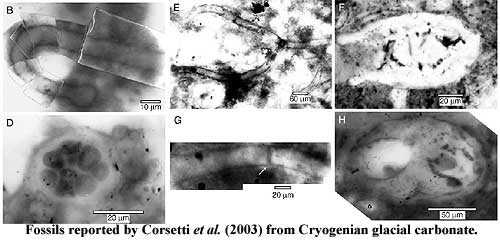 1. Hoffman & company explain the negative excursions with
a
complex, but plausible chain of reasoning involving global carbon burial
rates. However, the fact remains that organic material is the primary
source of 13C-depleted carbonate. Stromatolitic carbonates and
other organic remains are often found in association with the lower levels of
cap carbonates. Allen
& Hoffman (2005); Beyth
et al. (2001); Corsetti
et al. (2003); Frimmel
(2004); Halverson
et al. (2002); Hoffman
et al. (1998). How confident can we be that the results
are not being influenced by all this organic carbon? In fairness, we judge this
to be a small point.
1. Hoffman & company explain the negative excursions with
a
complex, but plausible chain of reasoning involving global carbon burial
rates. However, the fact remains that organic material is the primary
source of 13C-depleted carbonate. Stromatolitic carbonates and
other organic remains are often found in association with the lower levels of
cap carbonates. Allen
& Hoffman (2005); Beyth
et al. (2001); Corsetti
et al. (2003); Frimmel
(2004); Halverson
et al. (2002); Hoffman
et al. (1998). How confident can we be that the results
are not being influenced by all this organic carbon? In fairness, we judge this
to be a small point.
2. It isn't clear whether the cap carbonate δ13Cs are local or global, and whether the origin of the carbon is terrestrial (via runoff), marine, or dissolved carbon dioxide from the atmosphere. Under more normal circumstances, this would make no difference. However, the Snowball Earth hypothesis calls for all kinds of partitioning. During a Snowball event, for example, deep sea, superficial sea, ice cover, land, and atmosphere are all somewhat (or entirely) separate compartments. Hoffman et al. (1998) assumed that air, sea and ocean would all be in equilibrium with volcanic carbon dioxide (which has a negative δ13C). It is unclear why that would necessarily be the case for the oceans. In any case, Hoffman & Schrag (2002) invoke rapid weathering as the primary post-glacial source of carbonate. But this, as they state, involves weathering of preglacial carbonate shelves. So what are we measuring?
In addition, various authors have grumbled about effects of such factors as water depth on 13C. Halverson et al. (2002) (citing work of Holland); Frimmel (2004); Frimmel & Fölling (2004); c.f. Bartley & Kah (2004) (depth effect depends on productivity). Bear in mind, also, that the Snowball Earth model calls for a number of unusual changes of state for carbon: sublimation in intensely dry and cold conditions, possible CO2 freezing at the poles, very rapid freezing, thawing, and crystallization, and unusual crystal forms. It is unsafe to assume that none of these processes would impact δ13C. For an interesting example of isotope fractionation under similar unusual conditions, see Eiler & Kitchen (1999); Rahn & Eiler (2000); Socki et al. (2003) (simulated conditions on Mars).
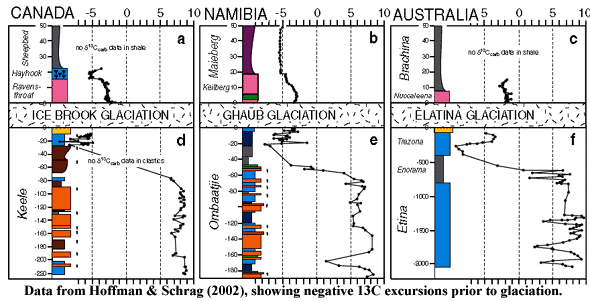 Alarums,
Excursions. Enter Warwick.
Alarums,
Excursions. Enter Warwick.
Warwick: Forspent with toil, as runners with a race,
I lay me down a little while to breathe;
For strokes receiv'd, and many blows repaid,
Have robb'd my strong-knit sinews of their strength,
And, spite of spite, needs must I rest awhile
-- Shakespeare, Henry VI, Part 3, Act III, Sc. 3
Another anomalous carbon anomaly is discussed by Halverson et al. (2002) and by Hoffman & Schrag (2002). As these authors note, the 13C values, like Shakespeare's Warwick, withdraw a little earlier than honor would allow. That is, the low values found in the cap carbonates actually begin in levels below the glacial ice. In fact, to our untutored eye, it appears that the negative excursions peak somewhat before the glaciation and that the cap carbonates smoothly continue a generally upward trend line which began before the glaciations. Halverson's group estimates that the negative excursion in Namibia began about 600,000 years before the Marinoan glaciation.
As far as we are aware, no satisfactory explanation has been offered for these peculiar results. (Halverson & Co. offer a game, but ultimately unsatisfactory explanation discussed below.) From the viewpoint of the carbon isotope record, it almost appears that the glaciers were inserted into a previously continuous series of strata, or that the glaciation formed part of a recovery phase from some earlier perturbation.
Before leaving this interesting, but entirely speculative topic, we should point out that, in some cases, little or no geological record of the actual glaciation exists. Thus, as shown in the image, pre-glacial and post-glacial carbonates are almost in contact, and may even interpenetrate. This makes the pre- and post-glacial isotope continuity seems more natural, but still entirely inexplicable.
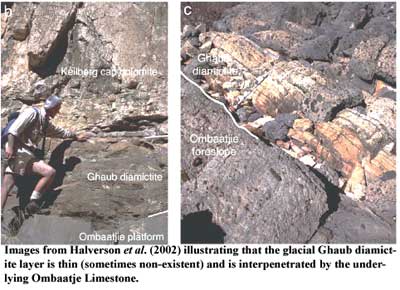 Alarums, excursions. Enter the Bastard, with Austria’s head
Alarums, excursions. Enter the Bastard, with Austria’s head
Bastard: Now, by my life, this day grows wondrous hot;
Some airy devil hovers in the sky
And pours down mischief ...
--Shakespeare. King John, Act III, Sc. 2.
Hoffman's group postulates a methane-related mechanism for the pre-glacial positive carbon isotope excursion. Perhaps we are simply jaded, but we are suspicious. Methane is currently a sort of compound de jour. In some areas, it has almost eclipsed extraterrestrial impacts as the explanation for all that is inexplicable. We admit to invoking methane in that manner several times ourselves. Certainly it has been speculated that methane production and/or methane clathrate releases may have been responsible for escaping the deep freeze. See, e.g., Kennedy et al. (2001). However, all of this appears to be erudite arm-waving at the moment.
With all that said, the explanation offered by Halverson et al. (2002) is not entirely ad hoc. The mechanism proposed by Halverson et al. is that a sustained release of methane from some oceanic source caused greenhouse warming, which promoted continental weathering, which drew down atmospheric carbon dioxide. When the methane release ended, the atmosphere contained low levels of both greenhouse gasses, triggering an ice age.
The subject has been reviewed by Holland (2003). Without, getting deeper into geochemistry than this discussion warrants, Holland concludes that excess methane production is possible, although there is no particular evidence to show that it actually occurred. The amount of methane being released to the atmosphere depends critically on the state of the oxygen and sulfate cycles, both of which were evolving rapidly during the Neoproterozoic. It also depends on the state of the deep oceans (mixed or unmixed, anoxic or otherwise). It is clear that, by the very end of the Neoproterozoic, both oxygen and sulfate were at much higher levels than at any previous time. However, the pace and timing of the change are unclear. See also, Kah et al. (2004) (arguing that the transition was very late). Thus, the state of methane during the Cryogenian and Early Ediacaran is an unknown quantity in an unknown geochemical system, which was probably out of equilibrium at any given time. As for the oceans, as Holland observes, we can be reasonably sure the deep oceans were at least locally anoxic during snowball events, since we find banded iron. However, as Holland also notes, that cuts both ways. Neoproterozoic banded iron is only found in association with Snowball events. Perhaps the oceans were otherwise well mixed. Accordingly, we can neither rule out nor accept a methane explanation at this point.
As mentioned above, the dating of the Snowball events is not exactly well-constrained. To confuse matters further, 13C excursions have frequently been used to date rock sequences with seeming confidence, when it is actually unclear whether they correspond to unique, world-wide events. Indeed, it seems that any poorly-sorted conglomerate overlaid by Proterozoic dolomite is assumed to be part of a "Snowball" event, even where no particular pattern of carbon excursions was found and dates were essentially unconstrained. See, e.g., Beyth et al. (2003). Such conclusions in the literature, like ice beyond 30º latitude, signal an unstoppable positive feed-back effect in which each "Snowball" finding increases the likelihood that the next study will also find one.
In fact, there is no reliable evidence that any of the Snowball events represent synchronous global phenomena. So far as we are aware, none of the (few) events with well-constrained dates are synchronous. The global nature of the events has generally been assumed from the 13C excursions, the thought being that 13C values will generally be in equilibrium with ocean values worldwide. Knoll et al. (2000) (dissenting comments of Sokolov et al.); Knoll (2000); Hoffman & Schrag (2002). However, most -- perhaps all -- of the well-documented Snowball carbonate sequences come from relatively restricted waters, a circumstance which is known to correlate with higher 13C values. Frimmel (2004). Allen & Hoffman (2005) argue that the presence of what they believe to be giant wave ripples in the cap carbonates suggests access to open oceans with unlimited fetch. However, their calculations require a number of critical assumptions, and it is unclear whether or not these authors may have inadvertently assumed their conclusions.
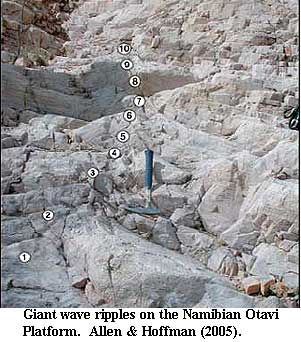 The
Snowball Earth theory requires a very quick deglaciation, driven by
extraordinary levels of atmospheric carbon dioxide. The evidence for
extremely fast deposition of carbonate caps is excellent in some areas. In
addition to large dolomite crystals, calcite "fans" and similar
structures are frequently observed. Allen
& Hoffman (2005) have recently reported tented structures attributable
to enormous waves (not tsunamis, but ordinary gravity waves) in many different
cap carbonates, consistent with the kind of brutal weather we would expect to
see in a rapidly melting world.
The
Snowball Earth theory requires a very quick deglaciation, driven by
extraordinary levels of atmospheric carbon dioxide. The evidence for
extremely fast deposition of carbonate caps is excellent in some areas. In
addition to large dolomite crystals, calcite "fans" and similar
structures are frequently observed. Allen
& Hoffman (2005) have recently reported tented structures attributable
to enormous waves (not tsunamis, but ordinary gravity waves) in many different
cap carbonates, consistent with the kind of brutal weather we would expect to
see in a rapidly melting world.
The last-named study aroused our slumbering curiosity, since it cited evidence from exposures not commonly mentioned in the Snowball literature. One of them, the Stelfox Member of the Ice Brook Formation, looks to be a fairly typical Snowball facies, but it occurs above the first occurrence of Ediacaran fauna, and also above another Marinoan Snowball sequence. The same may apply to the Spitzbergen succession (Wilsonbreen Fm.) mentioned by the same authors. See, Kaufman et al. (1997).
But, the embarrassing surplus of Snowball events aside, is there evidence for slower deglaciation? Apparently this is the case. We say "apparently" because it is often asserted to be true. Christie-Blick et al. (1999); Goodman & Pierrehumbert (2003). We have personally looked at only one such study. McMechan (2000). It is also unclear whether Christie-Blick and Hoffman's Snowball group are talking about the same thing when they discuss deglaciation. The former cites studies apparently dealing with continental ice masses, while Hoffman is mainly focused on sea ice. One could envision a case in which sea ice melted very rapidly, but continental ice sheets retreated much more slowly. Something similar may have occurred during the Pleistocene Ice Ages. However, unless continental ice also melted quickly, surface rock would not be available for the rapid weathering needed to draw down the excess carbon dioxide, thus prolonging the "hothouse" aftermath of the glaciers.
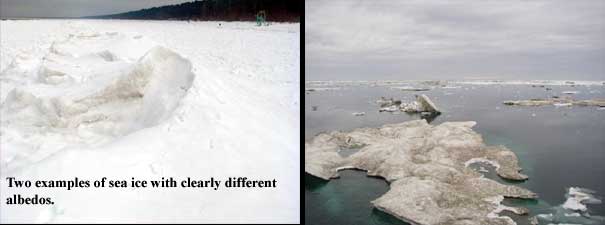 A number of workers have created computer models of greater or lesser
sophistication in an attempt to understand the complex interactions involved in
the Snowball phenomena. Poulson
et al. (2001); Goodman
& Pierrehumbert (2003);
Pierrehumbert
(2004); Poulson
& Jacob (2004); Pollard
& Kasting (2005). These are fascinating papers, particularly
Pollard & Kasting (2005) who go into great detail about the effects of
various assumptions, including the albedo parameters assumed for sea ice (a
critical and insufficiently examined parameter). Unfortunately, this type
of modeling pushes the limits of available computing power and requires
potentially unrealistic simplifying assumptions. Our personal favorite is
from Goodman & Pierrehumbert (2003: 3): "We ignore the existence of
continents ..." -- surely a remarkable statement for a geologist! In
fact, this was a perfectly sensible assumption in the context of what those
authors were doing, i.e. proving the importance of equatorwards ice flow
from both poles in maintaining the Snowball steady state. However, it underlines the
point that modeling results must be approached with a clear understanding of
their assumptions and limitations.
A number of workers have created computer models of greater or lesser
sophistication in an attempt to understand the complex interactions involved in
the Snowball phenomena. Poulson
et al. (2001); Goodman
& Pierrehumbert (2003);
Pierrehumbert
(2004); Poulson
& Jacob (2004); Pollard
& Kasting (2005). These are fascinating papers, particularly
Pollard & Kasting (2005) who go into great detail about the effects of
various assumptions, including the albedo parameters assumed for sea ice (a
critical and insufficiently examined parameter). Unfortunately, this type
of modeling pushes the limits of available computing power and requires
potentially unrealistic simplifying assumptions. Our personal favorite is
from Goodman & Pierrehumbert (2003: 3): "We ignore the existence of
continents ..." -- surely a remarkable statement for a geologist! In
fact, this was a perfectly sensible assumption in the context of what those
authors were doing, i.e. proving the importance of equatorwards ice flow
from both poles in maintaining the Snowball steady state. However, it underlines the
point that modeling results must be approached with a clear understanding of
their assumptions and limitations.
A number of potentially relevant factors might be added to these models. One factor which does not seem to have been included in any of the models is tide. Since tides were both more frequent and stronger in the Neoproterozoic than in the present day, this is distinctly odd. Perhaps we are mistaken, but it would appear that tidal heating and deformation might have a considerable impact on a worldwide ice sheet. Another factor we would like to see is some degree of random variation in the parameters. So, for example, Pollard & Kasting assume that 2% of the ocean surface is exposed through cracks ("leads") in the ice. Pollard & Kasting find that this is a surprisingly important variable in the results. A more realistic and informative choice might be to allow this parameter to vary randomly in different computational cells between 1 and 3%. Finally, with apologies to Goodman & Pierrehumbert, we'd like to see more continents. One of the modelling groups includes one big continent straddling the equator, but this is not ideal. Polar continents might have strong effects in limiting thick ice production, and thus equatorward glacial flow. Smaller, mid-latitude continents might create large, thin- or no-ice refugia on their equatorward sides as the sea glacier split to flow around them.
Thus far, two conclusions seem to emerge from the modeling studies. First, as Goodman & Pierrehumbert pointed out, the Snowball model necessarily requires a "sea glacier" that continuously transports ice and cold, fresh water from poles to equator. Second, "thin ice" and "slushball" scenarios are possible. That is, a hard frozen ice-ball is not necessarily required. A hard freeze does emerge as the result of most modeling runs, but the result depends on assumptions about fine points such as ice albedo, cloud cover (and cloud thermal properties), winds, precipitation, and the amount of sea surface exposed by cracks in the ice. Beyond these results, as Poulson & Jacob (2004) state: "At this stage in the modeling of Neoproterozoic climate, model results should not be used to argue one way or another for the existence of a Neoproterozoic snowball Earth. Rather, climate models should be used to gain insights into the processes or mechanisms that might contribute to promoting or inhibiting global sea-ice cover."
| Page Back | Unit Home | Page Top | Page Next |